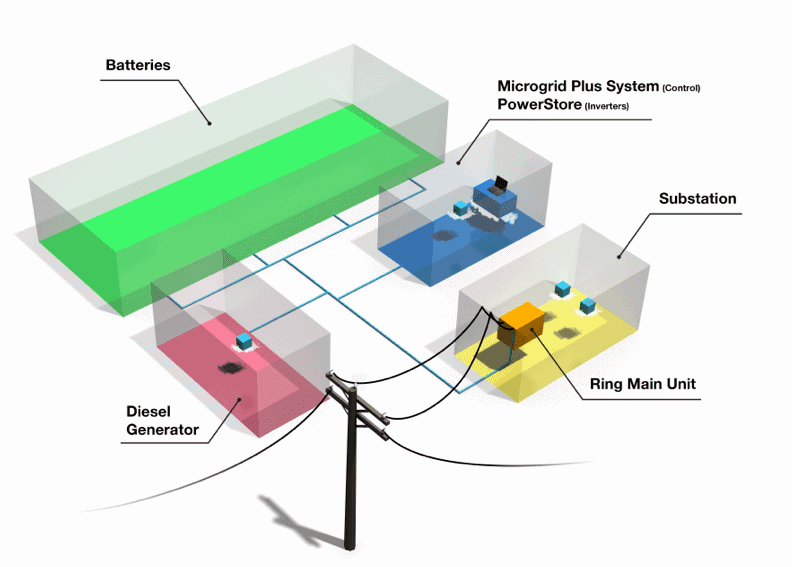Victorian network operator SP Ausnet has commissioned a 1MW/1MWh battery storage facility that could herald a new approach to dealing with peak demand, and avoid future costly network upgrades.
SP Ausnet is just the latest to invest in battery storage trials, but the project agreed with engineering group ABB and Korean industrial giant Samsung appears to be the largest of its type so far in Australia.
ABB and Samsung will build what they call a hybrid Grid Energy Storage and Diesel Generation System that will include the battery storage (using lithium ion batteries) and a 1MW diesel generator.
 According to ABB, the plant (illustrated right) will be a pilot for future grid-integrated storage systems that could be used to supply additional capacity during high demand periods and offset or delay expensive investment upgrades of power lines.
According to ABB, the plant (illustrated right) will be a pilot for future grid-integrated storage systems that could be used to supply additional capacity during high demand periods and offset or delay expensive investment upgrades of power lines.
While such systems are used in off-grid situation, this is said to be the first embedded grid-scale battery storage installation of its size in Australia, a country which is considered to be a prime market for battery storage because its networks have to cover such large distances.
Interestingly, the plant is a mobile device, which comes in seven containers and “kiosks” so it can be deployed at different parts of the network. The mobility factor explains the use of a diesel generator rather than gas.
SP Ausnet says it is clear that battery storage will play a growing role in electricity use in Australia in coming years. A spokesman said individual consumers were looking to install battery storage for their own purposes, and grid operators such as SP Ausnet were also looking to see how storage could best play a role in their networks.
SP Ausnet currently runs four 1MW diesel plants – all of which were used at various times during the heatwave in Victoria last week, but the spokesman said battery storage offered greater options and flexibility. SP Ausnet operates electricity distribution and transmission lines in Victoria, as well as a gas network. The new plant will be trialled at different locations.
Other network operators are also looking at battery storage in various forms. Ausgrid, the network operator in NSW, last year said it will install a 60kW battery storage system in the Sydney suburb of Newington to see how it can help manage summer peak demand events.
Queensland network operators Energex and Ergon have also recognised the looming impact of battery storage. Energex warned that as energy management options such as smart appliances, energy management software, in-home generation and battery storage become more available and affordable, “we expect to see a significant change in the way customers use energy and our network.” Ergon said it was likely customers could source solar and storage more cheaply than the network.
In Tasmania, Hydro Tasmania has commissioned Ecoult to intall the largest battery-based renewable energy storage system in Australia at its King Island Renewable Energy Project. The 3 MW/1.6 MWh UltraBattery storage system will complement other elements of Hydro Tasmania’s project, which in recent months has managed to switch off diesel generators for up to 90 minutes, relying solely on wind power.
The GESS system provides peak demand management, active and reactive power support and other power quality functions, can also provide power as part of a mini grid when parts of the network become isolated.
ABB says the battery system and smart inverter are the primary energy source for the unit, while the diesel generator acts as back-up to extend the capacity available.
The plant is managed by ABB’s new Microgrid Plus System – which it has tested in Darwin – and comes as a transportable power station consisting of seven outdoor containers and kiosks.
“ABB had the opportunity to demonstrate to SP AusNet the value of leading-edge technology that is available at its doorstep,” David Baker, ABB’s division manager for Power System in Australia, said in a statement.
The project is due to be completed in 2014.










